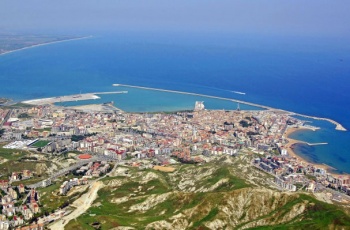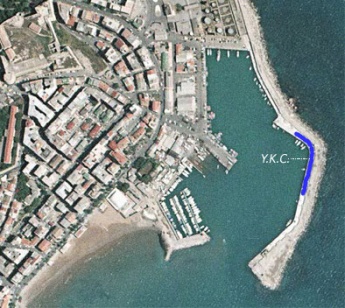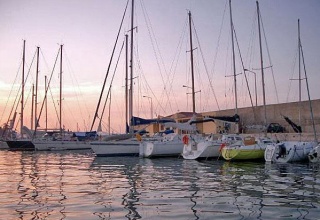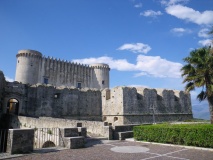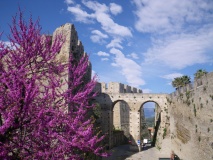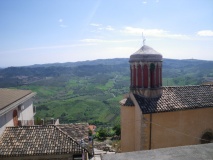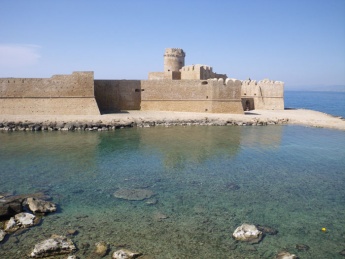Crotone
From CruisersWiki
| Crotone
| |
| | |
The harbour of Crotone lies on the Ionian coast of Italy, around 15 miles N of Capo Rizzuto at the extreme western corner of the Golfo di Taranto. The harbour of Crotone consists of a Porto Nuovo, a northern basin comprising the commercial port, and the Porto Vecchio, the southern basin, which has been developed for tourism. The harbour is a convenient launch pad for a passage across the Golfo di Taranto to Santa Maria de Leuca or even a long passage across to Corfu and the Greek mainland.
Charts
- British Admiralty
- 187 Punta Stilo to Brindisi
- Italian charts
- 919
- 25 Da Punta Stilo a Punta Staletti
- 146
Weather
During the summer the prevailing winds in the Ionian are light to moderate SW or SE sea breezes. In spring and autumn northerly winds are more frequent and can quickly rise to near gale force, especially in the lee of high mountain ranges. Winds in summer are generally light from the Straits of Messina until reaching the Golfo di Squillace between Roccella Ionica and Le Castella. With anything W in the wind, it tends to funnel down here over the mountains of southern Calabria, bringing strong gusts and raising an uncomfortable sea. The conditions to avoid, however, when cruising this part of the Ionian coast are strong southerlies. The harbours here are few and far between and none of them are really safe to enter in such conditions. Further east in the Gulf of Taranto local sea breezes predominate during the summer, although a light to moderate northerly is not uncommon.
Sources for weather information:
- There is a continuous (computerized voice) weather forecast on VHF 68 - first in Italian and then followed with an English translation
- The same forecast is given in Italian and English on VHF coastal stations following a notification on channel 16
- Navtex weather forecasts are broadcast from stations at Roma, Cagliari (Sardinia) and Augusta (Sicily)
Passages
See Aegean to West Mediterranean Passages.
Communication
Add here VHF channel for the coastguard, harbor masters. etc.
Also see Cruiser's Nets
There are no hazards in the approach to Crotone, other than numerous offshore gas rigs. The 16-century castle above the town is conspicuous from some distance off. Closer in, the long breakwater of the Porto Nuovo and the shorter one of the Porto Vecchio to the S join where a series of large oil tanks are visible on the shore. A yacht (unless it is a very large one) should normally proceed to the Porto Vecchio, which is entered from SSW around the curved breakwater. Only yachts with a maximum draught of up to 2.5 metres are allowed to enter. The commercial harbour to the N should only be used with permission from the port authorities (usually in very strong southerly winds, when the Porto Vecchio becomes extremely uncomfortable). Depths in the entrance to Porto Vecchio are 4.0 - 4.5 metres and in the harbour 3.5 - 5.5 metres.
Berthing
Yachts are normally berthed on the mole to starboard on entering the harbour, beyond the fuel quay. The small basin at the SW corner of the harbour is reserved for members of the Italian Lega Navale. In total, the harbour has 600 berths, of which 20 are reserved for yachts in transit.
Marinas & Yacht Clubs
Yachting Kroton Club
The transit berths on the mole all have laid moorings and are managed by the Yachting Kroton Club. Maximum length 25 metres. Water an electricity points on the quay. Showers and washing machine in the office on the mole. Contact them for reservations.
- [email protected]; Phone: +39 (0962) 061 544; Mobile: +39 (320) 611 5069; VHF channel 71
- Address: Molo Foraneo – Porto Vecchio, 88900, Crotone, Italy
Autonautica Tricoli
Also has some hard standing wintering space.
- [email protected]; Tel/Fax: +39 (0962) 22 852; Mobile: +39 (340) 340 832 0909; VHF channel XX
- Address: Via Porto Vecchio, 88900 Crotone, Italy
Porto Vecchio Service
In Banchina di Riva Porto Nuovo. Hard standing of 6000 square metres. Slipway. Mobile crane (75 T). Fixed crane (12 T). Engine, electrical and electronic repairs. Wood and fiberglass hull repairs. Anti-osmosis treatement. Paint works. Refrigeration and air conditioning work. Sail repairs. Divers.
Water and electricity, laundry. Toilets. Black water pumpout. Internet point Water, electricity, showers, WC.
- [email protected]; Tel/Fax: +39 (0962) 24 854; Mobile: +39 (335) 822 3803; VHF channel XX
- Address: Elio Balsano, 88900 Crotone, Italy
- Prices: Euros 1900 for 13 metres/12 months on the hard (2013) --JeanF73)
Anchorages
Yachts reported to anchor in front of the beach west of the harbour.
Amenities
| Facilities | |
|---|---|
| Water | Points on the quays |
| Electricity | Points on the quays |
| Toilets | In Yachting Kroton Club and Porto Vecchio Service |
| Showers | In Yachting Kroton Club and Porto Vecchio Service |
| Laundry | In Yachting Kroton Club and Porto Vecchio Service |
| Garbage | Bins on the quays |
| Supplies | |
| Fuel | Station on the pier to W of Porto Vecchio (0800 - 2000) |
| Bottled gas | ? |
| Chandlers | Small stores in town |
| Services | |
| Repairs | Many repairs in Porto Vecchio Service |
| Internet | WiFi in:
|
| Mobile connectivity | ? |
| Vehicle rentals | Rental outlets in the town |
Provisioning
Good provisions in the village.
Eating out
- Numerous restaurants in the town
- Café Rosa is very good (especially the home-made desserts)
Transportation
- Railway station with trains to most destinations
- Local and international flights from Crotone airport
- E90 road connects to Taranto and Reggio di Calabria
Tourism
History
Crotone is one of the oldest Greek colonies on the peninsula, Crotone was the leading settlement in what was later known as Magna Graecia. The city was renowned for producing successful athletes at the ancient Olympic games and for its famous physicians. In 530 BC Pythagoras founded his school of natural philosophy here. Later, during the Roman period, the city threw in its lot with the Carthaginian leader Hannibal during the Second Punic War, as a result of which it was severely punished on being recaptured in 205 BC. Crotone subsequently became part of the Byzantine empire until its capture by the Normans in the 11th century. For the next seven centuries, Crotone’s fate followed that of the Kingdom of Naples, including a period of Spanish occupation during the 16 century (from which its powerful castle dates), until the foundation of the Kingdom of Italy in 1861. A period of economic decline in the 1980s was only arrested with the growth of tourism in the last decade.
Places to Visit
Crotone and its hinterland offer still intact and extremely varied natural landscapes, going from the mountains of the Sila National Park to the unspoilt sea of "Capo Rizzuto" Marine Protected Area with its rare wildlife. It is during the Magna Graecia period (VII-I B.C.), that Crotone inherited the unique privilege of taking on the role of guardian of the history of this civilization. Even today, wherever one excavates, it is possible to uncover remains from the Greek age which saw Crotone at the height of its splendor in the 5th century BC.
During the course of the centuries Crotone has been home to several Mediterranean people, such as the Oenotrians, the Greeks, the Romans, the Byzantines, the Bruttii as well as of Franco-German origin, such as the Normans, the Suebi, the Angioins and the Bourbons. These populations, founders of western and Mediterranean civilization, have left visible traces of their greatest and culture. The stratification of the territory makes it possible to trace, at different depths, testimony to the different historic phases which have passed Crotone. The plan which privileged this area was not simply of a strategic character for the military defence of the coasts, but also for the environmental and cultural profile which characterize this territory.
The Town
Crotone was long one of the most flourishing cities of Magna Graecia. According to the historian Herodotus, the physicians of Crotone were considered the foremost among the Greeks. In 530 BC the mathematician Pythagoras founded his school in Crotone. Piazza Pythagoras is the most important square of Crotone and a meeting point for citizens. It is surrounded by porches built in the second half of the ‘800's. Walking through Via Vittorio Veneto we arrive in Piazza Duomo where the magnificent cathedral dating from the IX century is located.
CATHEDRAL: it has a neo-classical façade; the interior has a nave with two aisles and Baroque decorations. Noteworthy are a baptismal font (XII century) and the Madonna di Capo Colonna painting, the icon of the “Black Madonna” which, according to the tradition, was brought from the East in the first years of the Christian era.
S. CHIARA’S CHURCH: this small, beautiful church is part of the Poor Clares convent. The church is charcaterised by a beautiful Neapolitan majolica floor and a precious wooden crucifix from the XVIII century.
CHARLES V CASTLE: the castle stands in a imposing position in the highest point of the town, thus able to keep guard over the sea and the surrounding countryside. Today, it represents an enlarged reconstruction of the old, Medieval castle with the various modifications carried out during Angioin and Aragonian rule.
THE NATIONAL ARCHAEOLOGICAL MUSEUM: it is situated near the medieval castle and holds all the most significant finds coming from the archaeological areas of Crotone, especially Capo Colonna. Of great interest is the section dedicated to the so-called “treasure of Hera Lacinia”, with votive objects of extremely high artistic value, found in the sanctuary bearing the same name.
The crotonese craft is especially known for its skilled goldsmiths, who create magnificent jewels, often inspired by the Greek and Byzantine style.
Capo Colonna
Symbol of the city’s millenary history, the Doric column erected on the Capocolonna promontory (at about 13 km from the centre of Crotone) carries an echo of the splendour of the Magna Græcia period.
It is the only remaining column of the temple dedicated to the goddess Hera. Dating back to the 6th century B.C., it was one of the most important religious locations in Magna Græcia, upon which today stands Capocolonna Archaeological Park.
The Park is made of roughly 30,000 square meters of terrain allocated for excavations which brought to light the foundations of different buildings and domestic locations, along with 20 hectares of Mediterranean woods in which are present pleasant natural trails that lead from the museum to the column.
In the Park is situated the magnificent museum built into the earth, to limit its environmental impact. Divided into three sections (The Earth, The Sacred and The Sea), the Capocolonna Archaeological Museum gathers together artefacts found underwater, votive objects and parts of the temple.
Santa Severtina
Santa Severtina known as the "Stone Ship" because it clings imposingly to a tufa rock buttress overlooking the Neto river valley, the medieval "borgo" (village) of Santa Severina is listed among "The most beautiful villages in Italy" and renowned for the wonderful Carafa fortress.
The Castle is composed by a 15th-century square keep with four angular towers and the same number of jutting bastions. It is surrounded by a moat and encircling walls, with a section that offers examples of different types of crenellation (Byzantine, Norman and Suevian) The elegant salons are ornated with stuccoes and paintings by Francesco Giordano. Even the archaeological museum housed within it chronicles the historical evolutions of the castle and the town. From the 9th to the 11th century the town lived its period of greatest splendour: the Baptistry, which is accessed via a little door in the Cathedral, is the oldest Byzantine monument in Calabria: built between the 8th and the 9th century on a circular base with a Greek cross, it was originally a martyry and only later it became a baptistery.
The Church of Saint Filomena, an interesting example of Byzantine-Norman architecture, is an 11th century construction with a small dome decorated with little columns (a typical pattern in Armenian buildings). What was once the Church of the Pozzoleo has been restored, and today holds the crypt of Saint Filomena. It once held a beautiful holy-water font made of Parian marble, now in the interesting Diocesan Museum, situated alongside of the cathedral.
The Carrafa castle can be the magnificent location for cocktails and tasting of local products, as well as for any kind of events such concerts and stage shows.
Le Castella
Upon entering the ancient fishing village located about 20 km from Crotone, you will immediately see one of the seven fortresses on the horizon, which once stood along the gulf. As you get closer to the castle, the view becomes even more spectacular, as the castle sits on a small islet anchored to the shore by a tiny strip of land.
The fortress is on an irregular layout and was likely built by the Aragonese around an existing Angevin fortification, even though its initial construction has been dated back to 204 B.C.
The island-fortress of Le Castella is particularly enchanting at night, because of the way lights play on the water. In the village can be found a number of typical restaurants and handicraft shops.
Friends
Contact details of "Cruiser's Friends" that can be contacted for local information or assistance.
- Alfa 21 is a service company that created the web site Port of Crotone. For any enquiry about the town and its port you can send an Email
Forums
List links to discussion threads on partnering forums. (see link for requirements)
Links
- Crotone at the Wikipedia
- Port of Crotone is a website created in order to promote awareness of the Crotone area, as well as to promote the city as a port of call for cruise tourism.
- Crotone Porto Vecchio Pagine Azzurre
References
See Italy.
Comments
We welcome users' contributions to the Wiki. Please click on Comments to view other users' comments, add your own personal experiences or recommend any changes to this page following your visit.
Verified by
Date of member's last visit to Crotone and this page's details validated:
- May 2004 --Athene of Lymington 15:39, 20 December 2010 (UTC)
| This is a usable page of the cruising guide. However, please contribute if you can to help it grow further. Click on Comments to add your personal notes on this page or to discuss its contents. Alternatively, if you feel confident to edit the page, click on the edit tab at the top and enter your changes directly. |
| |
|---|
|
Names: Lighthouse, Athene of Lymington, Portofcrotone |
